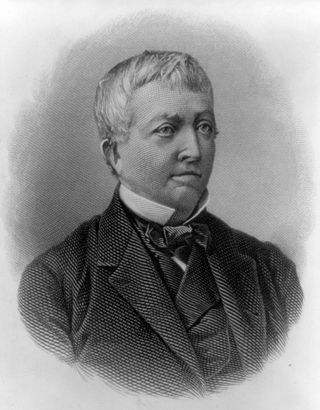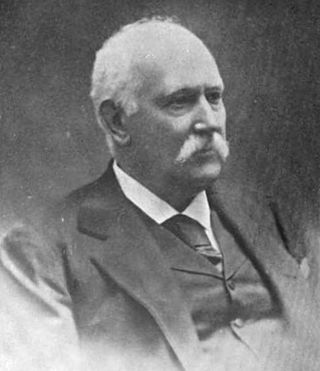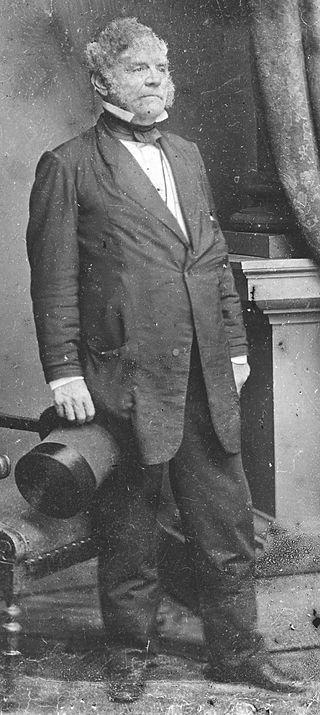
Benjamin Harris Brewster was an attorney and politician from New Jersey, who served as United States Attorney General from 1881 to 1885.

John Lee Carroll, a member of the United States Democratic Party, was the 37th Governor of Maryland from 1876 to 1880.

Oden Bowie, a member of the United States Democratic Party, was the 34th governor of the State of Maryland in the United States from 1869 to 1872.

Green Mount Cemetery is a historic rural cemetery in Baltimore, Maryland, United States. Established on March 15, 1838, and dedicated on July 13, 1839, it is noted for the large number of historical figures interred in its grounds as well as many prominent Baltimore-area families. It retained the name Green Mount when the land was purchased from the heirs of Baltimore merchant Robert Oliver. Green Mount is a treasury of precious works of art, including striking works by major sculptors including William H. Rinehart and Hans Schuler.

David Stewart was an attorney and politician from Baltimore, Maryland. A Democrat, he was most notable for his service in the Maryland Senate and his brief service as an interim U.S. Senator from 1849 to 1850.

Thomas Holliday Hicks was a politician in the divided border-state of Maryland during the American Civil War. As governor, opposing the Democrats, his views accurately reflected the conflicting local loyalties. He was pro-slavery but anti-secession. Under pressure to call the General Assembly into special session, he held it in the pro-Union town of Frederick, where he was able to keep the state from seceding to join the Confederacy.

William Henry Winder was an American soldier and a Maryland lawyer. He was a controversial general in the U.S. Army during the War of 1812. On August 24, 1814, as a brigadier general, he led American troops in their disastrous defeat at the Battle of Bladensburg, which led to the Burning of Washington by British troops. Winder was court-martialed for his role in the battle, but acquitted of any wrongdoing. He later became a leading attorney of the Baltimore bar.

Levin Winder in Baltimore, Maryland. During the Revolutionary War, he was appointed major of the 4th Maryland Regiment, finally attaining the rank of lieutenant colonel at war's end. After the war, he served with the Maryland Militia at the rank of brigadier general.

Saint John's Catholic Prep is a private, Roman Catholic, coeducational, college preparatory high school in Buckeystown, Maryland, located just southwest of Frederick City. At the time of its founding in 1829, it was located on Second Street in eastern downtown Frederick. Beginning in 1958 and for 45 years thereafter, the school was housed in the historic "Prospect Hall" mansion, (1787–1803), also just southwest of Frederick. St. John's was the first independent Roman Catholic school in the state of Maryland. It was also the first Roman Catholic secondary school in the state of Maryland.

L'Hermitage Slave Village Archeological Site is an archaeological site near Frederick in Frederick County, Maryland. The location, within the boundaries of Monocacy National Battlefield, was the site of l'Hermitage Plantation, founded about 1793 by the Vincendière family. The Vincendières are believed to have been former Haitian landowners who had fled the Haitian Revolution to the Catholic-leaning state of Maryland. L'Hermitage was notable during its time for its size, brutality and for the large number of slaves on the property.
The Adjutant General of Maryland is the head military official of the Maryland National Guard, the Maryland Defense Force, and any other military or paramilitary units that may be maintained by the State of Maryland. The adjutant general is responsible for the military department's budget and maintains all State-owned armories in Maryland.

Enoch Colby Chase was an American physician, businessman, and Milwaukee County pioneer. He served three years in the Wisconsin State Senate and five terms in the State Assembly, representing southern Milwaukee County.

St. John's Cemetery is a Roman Catholic cemetery located in Frederick, Maryland. The cemetery is operated by St. John the Evangelist Holy Catholic Church in Frederick, Maryland. The cemetery is located at East 3rd Street Frederick, Maryland 21701.

James Madison Buchanan was a Baltimore, Maryland jurist and diplomat.

William Frick was a justice of the Maryland Court of Appeals from 1848 to 1851.
William Hallam Tuck was a lawyer, judge and banker who served as a justice of the Maryland Court of Appeals from 1851 to 1861.
Governor Lowe may refer to:
Daniel S. Biser was an American politician. He served as member of the Maryland House of Delegates from 1837 to 1839, 1841 to 1842, 1844 to 1845 and in 1849. Biser served as Speaker of the Maryland House of Delegates in 1841 and 1842.
John C. Polk was an American politician from Maryland. He served as a member of the Maryland House of Delegates, representing Harford County in 1839.
















